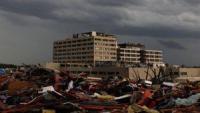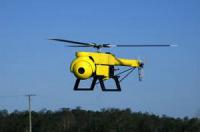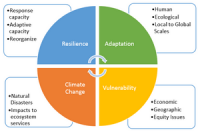-
Droughts caused permanent loss to major California groundwater source
California’s Central Valley aquifer, the major source of groundwater in the region, suffered permanent loss of capacity during the drought experienced in the area from 2012 to 2015.
-
-
A new way to sense earthquakes could improve early warning systems

Every year earthquakes worldwide claim hundreds or even thousands of lives. Forewarning allows people to head for safety and a matter of seconds could spell the difference between life and death. Researchers demonstrate a new earthquake detection method — their technique exploits subtle telltale gravitational signals traveling ahead of the tremors. Future research could boost early warning systems.
-
-
Potential impacts of future heat waves on humans and wildlife
Climate change is often talked about in terms of averages — like the goal set by the Paris Agreement to limit the Earth’s temperature increase to 2 degrees Celsius. What such numbers fail to convey is that climate change will not only increase the world’s average temperature, it will also intensify extreme heat waves that even now are harming people and wildlife.
-
-
Feeling the heat: Recognizing the risks of extreme weather
Heat waves are more dangerous than tornadoes, statistically. They kill more people than sharks, and put more human lives at risk than blizzards, floods or lightning storms. But they lack a certain dramatic flair, making it surprisingly difficult for many people to grasp and evaluate the real danger lurking behind their devastating effects. Recognizing those risks could be a matter of life or death – especially as a changing climate is making dangerous extreme heat events more and more likely every year in the United States.
-
-
Dealing with disaster

It took less than 90 minutes before students in Miaki Ishii’s first-year seminar started to talk openly about revolt. The unrest, however, wasn’t due to any political issue currently making headlines, but to a small room in Harvard’s Geological Museum and a handful of their classmates. The students took part in a role-playing game that saw them acting as citizens of the island of Montserrat, the tiny country’s government, and a group of scientists monitoring the island’s volcano. Why revolt? Because the students soon grew skeptical of the government’s ability to quickly and effectively respond to pressing environmental concerns.
-
-
Climate tool points to end of winter by 2050
Researchers have designed a tool which takes existing data and communicates the impacts of climate change in a way that people can engage with and better understand. The resulting new climate tool visualizes data which shows by 2050, Australians will no longer enjoy winter as they know it today and will experience a new season the designers are calling “New Summer.”
-
-
Forecasters use Iron Dome science to handle disasters

Typhoons, floods, droughts, earthquakes, hurricanes, wildfires — the frequency and intensity of natural disasters across the globe are worsening, and these deadly events could continue plaguing the planet as a result of climate change. Iron Dome tech firm uses rocket science to enable utilities to plan for and manage effects of wildfires, storms, hurricanes and earthquakes.
-
-
Wildfire risk in California no longer linked to winter precipitation
From 1600 to 1903, the position of the North Pacific jet stream over California was linked to the amount of winter precipitation and the severity of the subsequent wildfire season, the team found. Wet winters brought by the jet stream were followed by low wildfire activity, and dry winters were generally followed by higher wildfire activity. Wet winters no longer predict possible relief from severe wildfires for California, according to a new study.
-
-
Fast, simple new method for assessing earthquake hazard
Geophysicists have created a new method for determining earthquake hazards by measuring how fast energy is building up on faults in a specific region, and then comparing that to how much is being released through fault creep and earthquakes.
-
-
Asteroids are harder to destroy than previously thought
A popular theme in the movies is that of an incoming asteroid that could extinguish life on the planet, and our heroes are launched into space to blow it up. But incoming asteroids may be harder to break than scientists previously thought, finds a new study that used a new understanding of rock fracture and a new computer modeling method to simulate asteroid collisions.
-
-
Emission regulatory rollback: 200M metric tons of additional green house gasses annually
Following the release of the Fourth National Climate Assessment, the Trump administration is proposing to give four top climate-polluting industries a pass. A new report says that six specific regulatory rollbacks will cause an annual increase of more than 200 million metric tons of carbon dioxide equivalent, resulting in the loss of hundreds of billions of dollars in forgone benefits, and lead to tens of thousands of premature deaths.
-
-
Autonomous drones can help search and rescue after disasters

When disasters happen – whether a natural disaster like a flood or earthquake, or a human-caused one like a mass shooting or bombing – it can be extremely dangerous to send first responders in, even though there are people who badly need help. Drones are useful, and are helping in the recovery after the deadly Alabama tornadoes, but most require individual pilots, who fly the unmanned aircraft by remote control. Autonomous drones could cover more ground more quickly, but would only be more effective if they were able on their own to help rescuers identify people in need.
-
-
“Clustering” land buyouts could improve flood resiliency after Hurricane Harvey
A new study analyzes flood loss claims and estimates from over 74,000 properties impacted by Hurricane Harvey in Houston’s Harris County. The study finds that a strategic land buyout approach that prioritizes the purchase of land parcels in ‘clusters,’ as well as proximity to existing open space, is just as cost-effective as the traditional, piecemeal approach but with major added ecological and social benefits.
-
-
Resilience and adaptation strategies can address the impacts of climate change

By the end of this century, Chicago could face the kind of searing summer heat that Las Vegas sees now. Phoenix could hit 110 degrees, 60 or more days a year. That’s not wild speculation. It’s the official position of 13 federal agencies on climate change, released late last year with a warning: Local governments need to do more to prepare. Every road they build, every storm drain they put in, will have to hold up under conditions that modern civilization has never seen. How do you plan for that? Researchers at RAND have been working on that problem for a while now.
-
-
Population increases, climate change will cause future U.S. water shortages
Climate change plus population growth are setting the stage for water shortages in parts of the U.S. long before the end of the century, according to a new study. Even efforts to use water more efficiently in municipal and industrial sectors won’t be enough to stave off shortages, say the authors of the new study. The results suggest that reductions in agricultural water use will probably play the biggest role in limiting future water shortages.
-
More headlines
The long view
The Surprising Reasons Floods and Other Disasters Are Deadlier at Night
It’s not just that it’s dark and people are asleep. Urban sprawl, confirmation bias, and other factors can play a role.
Why Flash Flood Warnings Will Continue to Go Unheeded
Experts say local education and community support are key to conveying risk.
